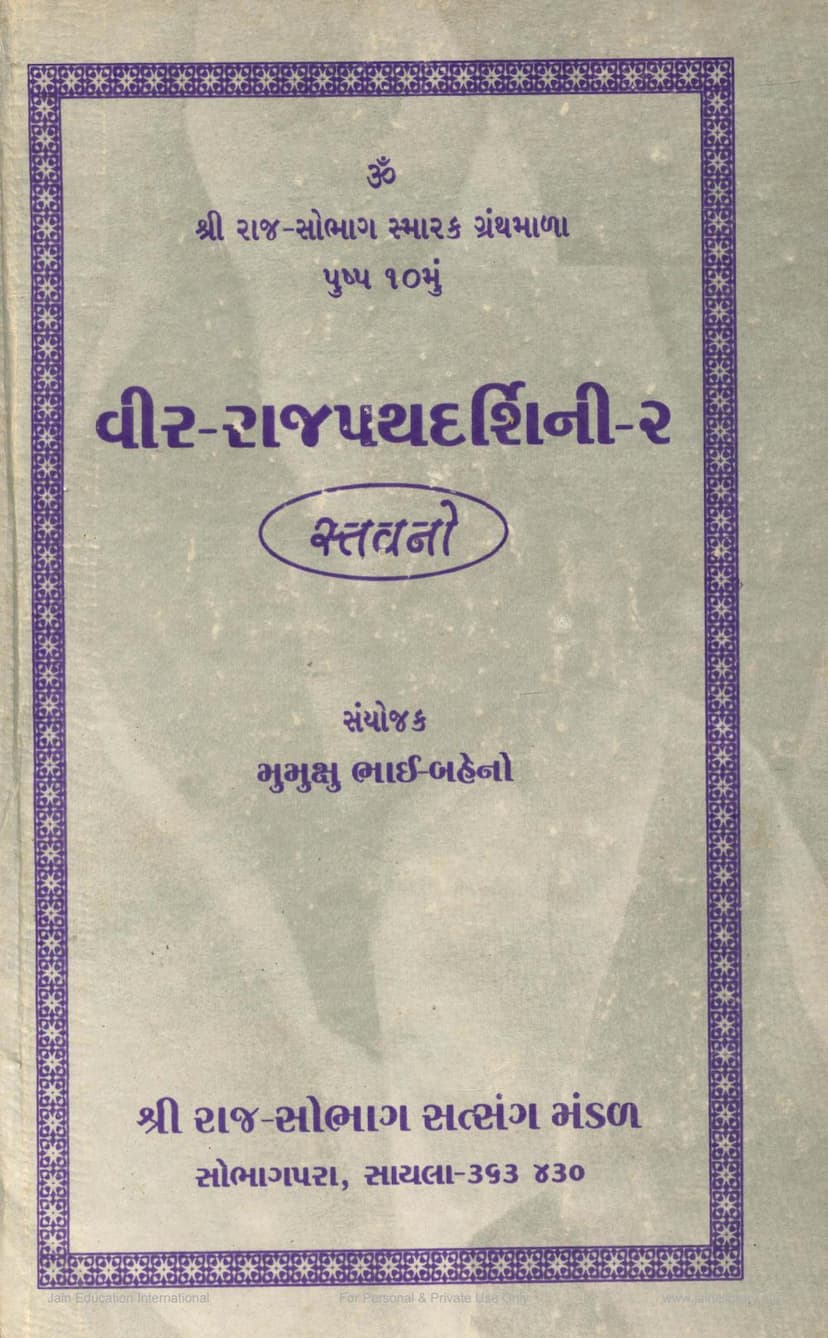Veer Raj Pathdarshini 02
Added to library: September 2, 2025

Summary
Here's a comprehensive summary of the Jain text "Veer Raj Pathdarshini 02," based on the provided pages:
Overall Purpose and Context:
"Veer Raj Pathdarshini 02" (Meaning "Heroic Royal Path Guide - 02") is a Jain religious text published by the Shri Raj-Sobhag Satsang Mandal Sayla. It is part of the Shri Raj-Sobhag Smarak Granthmala (Shri Raj-Sobhag Memorial Book Series), specifically the 10th volume, and is the second part of the "Veer-Rajpathdarshini" series. The book is dedicated to P.P. Shri Ladakchand Maneckchand Vora, referred to as "Pujya Bapuji." The text aims to guide spiritual seekers on the path of liberation, drawing from the teachings of prominent Jain acharyas.
Key Content and Structure:
The core of the book consists of the Chovisi (Chovisi) of several revered Jain acharyas, presented with their Bhavaarth (meaning/essence/commentary). The Chovisi refers to a collection of 24 verses or stanzas, typically dedicated to each of the 24 Tirthankaras, highlighting their spiritual significance and virtues.
The text includes the following acharyas and their Chovisi:
-
Yogeshwar Shri Anandghanji: This section features 10 stanzas from Anandghanji's Chovisi, each followed by its Gujarati meaning. The verses often address a "sakhi" (friend/companion) and discuss themes of true love, attachment to worldly possessions versus spiritual realization, the futility of certain religious practices, and the importance of inner contentment for spiritual fulfillment.
-
Shrimad Devchandji: This section presents the Chovisi of Shrimad Devchandji, also with detailed Gujarati meanings. Devchandji's verses are deeply philosophical and focus on:
- The nature of love and devotion towards the Tirthankaras, distinguishing it from worldly attachments.
- The principles of cause and effect, the role of Tirthankaras as guiding forces, and the necessity of sincere devotion.
- The stages of spiritual development, the importance of the Tirthankaras' teachings (Aagams) and the role of a Guru.
- The concept of the soul's inherent nature, the process of liberation, and the path to achieving it through practices like meditation and renunciation.
- The significance of devotion and worship, explaining different types of devotion and their outcomes.
- The qualities of the Tirthankaras, such as their detachment, compassion, and supreme knowledge.
- The spiritual journey and the ultimate goal of achieving liberation.
- The importance of right perspective (Naya) in understanding spiritual truths.
- The path to spiritual realization through self-effort and divine grace.
- The profound impact of Tirthankara's teachings and the need to follow them for ultimate bliss.
-
Mahopadhyay Yashovijayji: This section contains the Chovisi of Yashovijayji, with Gujarati meanings. Yashovijayji's verses emphasize:
- The divine qualities of the Tirthankaras and the joy derived from their darshan.
- The importance of divine qualities and the wonder of their attainment.
- The inadequacy of worldly comparisons to describe the Tirthankaras' greatness.
- The attainment of all virtues and the removal of all faults by the Tirthankaras, with a plea for spiritual bliss.
-
Shrimad Mohanvijayji: This section features the Chovisi of Mohanvijayji, also with Gujarati meanings. Mohanvijayji's verses often express a personal, devotional plea to the Tirthankaras, highlighting:
- A direct and sometimes confrontational approach, questioning the Tirthankara's perceived distance or inaction.
- The devotee's unwavering love and persistence in seeking spiritual realization.
- The perceived shortcomings of other deities compared to the Tirthankaras.
- The importance of divine grace and the ultimate reliance on the Tirthankara for liberation.
- The transformative power of devotion and the hope for attaining the Tirthankara's state of bliss.
Compilation and Editorial Process:
The book was compiled by "Mumukshu Bhai-Baheno" (Seekers Brothers and Sisters) and published by the Shri Raj-Sobhag Satsang Mandal Sayla. The publication committee expresses gratitude to individuals like Vasantben and Rasikbhai for their efforts in preparing the book. The publisher acknowledges the book's first edition in Vikram Samvat 2042 (1986 CE) and a second edition in Vikram Samvat 2054 (1998 CE), with a print run of 1000 copies each.
Key Themes and Teachings:
- Devotion and Love for Tirthankaras: A central theme is the deep love, devotion, and unwavering faith towards the Tirthankaras. The verses express a yearning for their darshan and a desire to emulate their virtues.
- Spiritual Liberation (Moksha): The ultimate goal of the spiritual path, Moksha, is consistently alluded to as the state of ultimate bliss and freedom from the cycle of birth and death.
- The Role of the Soul and its Nature: The text delves into the inherent nature of the soul, its potential for purity, and the obstacles created by karma and worldly attachments.
- The Importance of Right Knowledge and Conduct: The teachings underscore the necessity of right faith (Samyak Darshan), right knowledge (Samyak Gyan), and right conduct (Samyak Charitra) – the three jewels of Jainism.
- Distinguishing True Devotion from Worldly Pursuits: The verses often differentiate between superficial devotion and genuine spiritual aspiration, emphasizing the need for a pure, selfless, and unwavering heart.
- The Guru's Significance: The text implicitly and explicitly highlights the importance of a Guru (Sadguru) in guiding the seeker on the right spiritual path.
- Philosophical Concepts (Naya, Svadavada): Some sections touch upon Jain philosophical concepts like Naya (standpoints) and Svadavada (many-sidedness of reality) to explain the complexities of spiritual truth.
- Transformative Power of Devotion: The Chovis provide examples of how sincere devotion can lead to the shedding of negative karma and the realization of the soul's true, liberated state.
Overall Significance:
"Veer Raj Pathdarshini 02" serves as a valuable resource for Jain spiritual practitioners. It offers deep insights into the teachings of eminent acharyas, presented in a devotional and accessible manner through the Chovisi. The inclusion of the meanings makes the complex philosophical concepts understandable, fostering a deeper connection with the spiritual path and the virtues of the Tirthankaras. The dedication to "Pujya Bapuji" suggests a lineage of spiritual guidance and a continuation of their teachings.